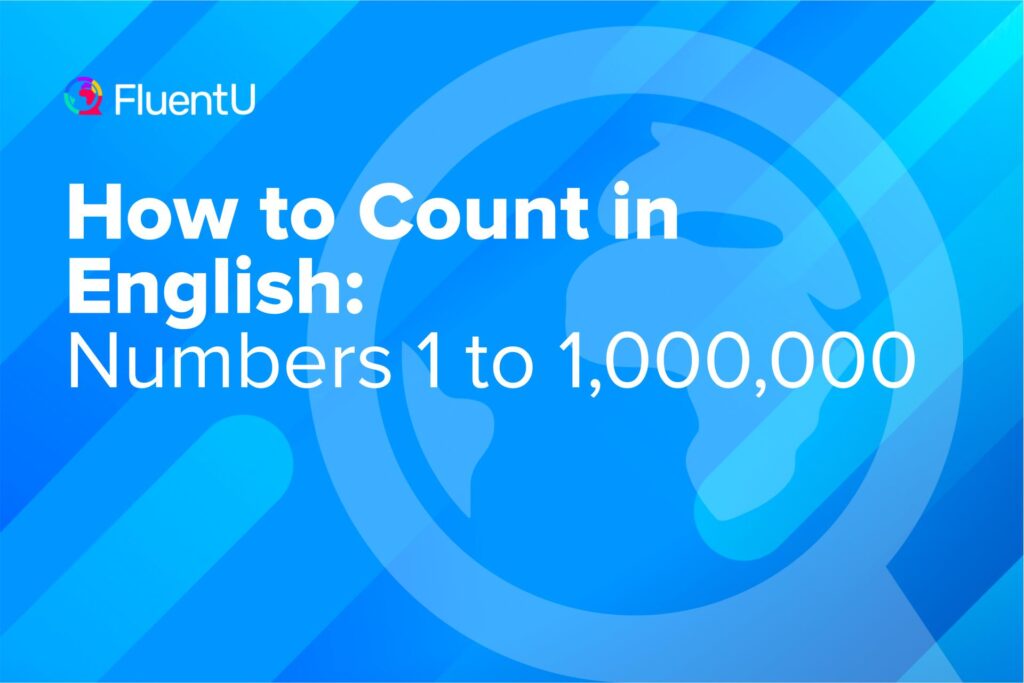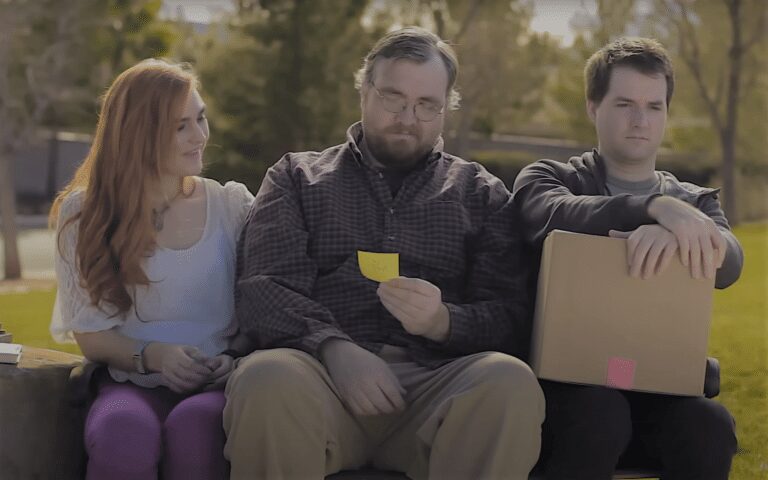How to Count in English: Numbers 1 to 1,000,000

Learning to count in English can be difficult for language learners, especially since large numbers can become very complex (not to mention the fact that English speakers from different regions say and pronounce some numbers totally differently).
If you are looking to count in English with ease, you should identify patterns that will make it much easier to learn number sequences—even big, complicated ones. Patterns add meaning and organization, ensuring that you’re not just memorizing blindly. In this article, we will show you several counting patterns to look out for.
Download: This blog post is available as a convenient and portable PDF that you can take anywhere. Click here to get a copy. (Download)
Cardinal Numbers
In simple terms, cardinal numbers are figures that denote quantity. For example, “there are five eggs in the basket.” The number five is a cardinal number as it tells us the quantity of eggs in the basket. These are the numbers that students learn when they’re studying English for beginners.
Before we get into the details, here’s a quick introduction to some of the most commonly used numbers in English:
Counting from 0 to 20
These cardinal numbers are the ones you will use most often in daily life. Plus, as you will see later in this article, most of the names for larger cardinal numbers are based on these numbers.
The first number in our list below can be pronounced in several different ways: “Zero,” “Oh,” “Nought” and “Nil.” However, “zero” is the more common usage.
“Oh” is sometimes used when reading a string of numbers out loud. For example, room 801 in a hotel could be read as “room eight-oh-one.”
“Nought” can only be found in British English, sometimes in terms of expressing a decimal. For example, the percentage 0.05% can be read as “nought point nought five percent.”
Meanwhile, “nil” is often used to express a game score between two competitors. For example, the soccer game score of 2-0 can be read as “two-nil.”
1 — one
2 — two
3 — three
4 — four
5 — five
6 — six
7 — seven
8 — eight
9 — nine
10 — ten
11 — eleven
12 — twelve
13 — thirteen
14 — fourteen
15 — fifteen
16 — sixteen
17 — seventeen
18 — eighteen
19 — nineteen
20 — twenty
Counting in Tens
Numbers that you can count in tens (20, 30, 40, 50, 60, 70, 80, 90) will always end with the letters “ty” (pronounced “tee”).
For example, the number 20 is twenty. Similarly:
30 — thirty
40 — forty (notice that it is not spelled fourty)
50 — fifty
60 — sixty
70 — seventy
80 — eighty
90 — ninety
Counting Any Double Digit Number
The double digit numbers are 10 through 99 (in other words, the numbers with two digits).
Once you know how to count to 20 and how to count in tens, you can easily count any of the remaining double digit numbers. All you have to do is combine the vocabulary.
Simply say the “tens” form of the first digit, then say the number in the second digit. For example, the number 76 can be read as seventy-six (not seven-six or seven-sixty).
Let us review more examples:
42 — forty-two
81 — eighty-one
29 — twenty-nine
67 — sixty-seven
56 — fifty-six
33 — thirty-three
Counting Hundreds and Thousands
Notice that a comma is placed to separate groups of three digits:
100 — one hundred
1,000 — one thousand
10,000 — ten thousand
100,000 — one hundred thousand
1,000,000 — one million
Counting Complex Large Numbers
Do not be taken aback by big numbers. Everything is about combining vocabulary that we have already learned. Just try breaking down big numbers into bite-sized readable content.
134 — One hundred and thirty-four
831 — Eight hundred and thirty-one
1,211 — One thousand, two hundred and eleven
4,563 — Four thousand, five hundred and sixty-three
131,600 — One hundred and thirty-one thousand, six hundred
903,722 — Nine hundred and three thousand, seven hundred and twenty-two
Ordinal Numbers
Now that you have learned about cardinal numbers, it is time for some ordinal numbers! Ordinal numbers tell you the position of something in a sequence.
You only have to remember the first group of ordinal numbers, and the rest will be easy!
Maybe you have already heard these used in sports competitions, like the Olympics. First place wins gold, second place takes silver, third place takes bronze, etc.
1st — first (number one in a sequence)
2nd — second (number two in a sequence)
3rd — third (number three in a sequence)
4th — fourth (number four in a sequence)
Examples:
Jimmy was the best artist in the art competition today. He won first prize!
Tom came to school early today. He was the second student to arrive.
You were the third person to comment on my Facebook post. My parents commented before you.
I am the fourth child in the family, so everyone treats me like a baby.
Counting Any Ordinal Number
Now you can turn any cardinal number into an ordinal number by following these rules:
- Any number that ends in the digit 1 will get the “st” ending.
- Any number that ends in the digit 2 will get the “nd” ending.
- Any number that ends in the digit 3 will get the “rd” ending.
- Any number that ends in the digits 4-9 or 0 will get the “th” ending.
For example:
101st — one hundred and first
42nd — forty-second
33rd — thirty-third
74th — seventy-fourth
87th — eighty-seventh
The only exceptions involve the numbers “11,” “12,” and “13.” These ordinal numbers are also denoted with “th.”
11th — eleventh
12th — twelfth
13th — thirteenth
Fractions
You probably recognize fractions from math class. Numerically, they are written as two numbers with a dividing line between them, e.g. “1/3.” But how do you actually say these numbers in English?
The numerator (top number of the fraction) should be recited like a cardinal number. The denominator (bottom number of the fraction) should be recited like an ordinal number.
Unless the numerator is one, make sure to put the denominator in plural form.
1/3 — one third
2/3 — two thirds
1/100 — one one hundredth
12/16 — twelve sixteenths
There are just two important exceptions:
1/2 — one half (not one second)
1/4, 2/4, 3/4 — one quarter , two quarters , three quarters (although saying “one fourth,” “two fourths” or “three fourths” would also be acceptable)
Regional Differences in English Counting
You need to recognize that, like most English words, numbers are pronounced differently by different people. For example, this video from Numberphile talks about the struggles that an American living in the U.K. faces when it comes to reading numbers.
The list is not exhaustive, but here are some observable differences between the U.S. and the U.K. when it comes to counting in English.
Do not panic when someone else says a number in a way that is different from how you memorized it.
People may read a string of numbers differently because of culture or custom, for example American English vs. British English. Try being open to these variations and perhaps even pick up a couple of new ways to count!
Reading Identical Numbers in Consecutive Order
The British typically lump consecutive numbers together while the Americans tend to read them separately. For example, imagine you had to read the serial number, 91333-4155:
U.K.: Nine one triple three, four one double five
U.S.: “Nine one three three three, four one five five
Grouping Numbers in the Thousands
There is a certain type of number that Americans will say differently than British people. It is easiest to see it by example:
2,400:
U.K.: Two thousand, four hundred
U.S.: Twenty-four hundred
3,700:
U.K.: Three thousand, seven hundred
U.S.: Thirty-seven hundred
9,800:
U.K.: Nine thousand, eight hundred
U.S.: Ninety-eight hundred
However, if you use the British version in the U.S., no one will think it is strange.
Including or Excluding the Term “And”
Imagine having to face a long string of numbers. How would you break it down? It is a British custom to insert the term “and” just before the last numerical expression, while this tradition is absent in American English.
542:
U.K.: Five hundred and forty-two
U.S.: Five hundred forty-two
Tricks to Learn English Counting Faster
- Use visual objects or involve your senses when learning numbers: Take charge of your learning by involving your five senses (what you see, hear, smell, taste and touch). It can be as simple as counting a row of rose bushes while walking down the street to your favorite new café.
Involving your senses while practicing English will help you remember new words better. When you pay attention to your immediate surroundings, your brain is forced to be present in the moment, absorbing new knowledge. It also allows you to find the connection between real physical items and abstract numerical vocabulary.
- Practice with flashcards: Flashcards are a great way to practice what you have learned because they require instantaneous responses. The more you practice, the shorter reaction time you will need when reading numbers. Use the flashcards on FluentU for contextual learning through videos and quizzes.
FluentU takes authentic videos—like music videos, movie trailers, news and inspiring talks—and turns them into personalized language learning lessons.
You can try FluentU for free for 2 weeks. Check out the website or download the iOS app or Android app.
P.S. Click here to take advantage of our current sale! (Expires at the end of this month.)

- Practice all day and all night! Need I say more? The only way to digest what you have learned is to practice until fluent!
Counting fluently in English will require time and effort. Try being open to the different variations of reading numbers. Happy practicing!
Download: This blog post is available as a convenient and portable PDF that you can take anywhere. Click here to get a copy. (Download)
And One More Thing...
If you like learning English through movies and online media, you should also check out FluentU. FluentU lets you learn English from popular talk shows, catchy music videos and funny commercials, as you can see here:
The FluentU app and website makes it really easy to watch English videos. There are captions that are interactive. That means you can tap on any word to see an image, definition, and useful examples.
For example, when you tap on the word "searching," you see this:
Learn all the vocabulary in any video with quizzes. Swipe left or right to see more examples for the word you’re learning.

FluentU helps you learn fast with useful questions and multiple examples. Learn more.
The best part? FluentU remembers the vocabulary that you’re learning. It gives you extra practice with difficult words—and reminds you when it’s time to review what you’ve learned. You have a truly personalized experience.
Start using the FluentU website on your computer or tablet or, better yet, download the FluentU app from the iTunes or Google Play store. Click here to take advantage of our current sale! (Expires at the end of this month.)












